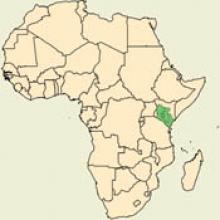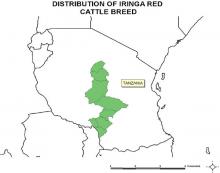Kenyan Sahiwal
Origin and distribution: The Sahiwal or `Montgomery' is largely bred in the Montgomery, Punjab region of Pakistan or the present day Sahiwal district. The Sahiwal are widely bred in India, Australia and Kenya. They were also introduced to Jamaica, Guyana, Burundi, Somalia, Sierra Leone and Nigeria. The present Sahiwal cattle in Kenya are descendants of some 60 bulls and 12 cows imported between 1939 and 1963. The high grade Sahiwals are owned by the National Sahiwal Stud at Navaisha whereas a few high grade Sahiwals and Sahiwal crossbred cattle are owned by private commercial breeders [CS 1.10 by Okomo]; [CS 1.11 by Gwakisa].
Physical characteristics: The Sahiwal are commonly of reddish dun colour although there are many animals with pale red; a dark brownish colour is common around the hump and neck; in males the colour darkens towards the extremities, such as head, legs and tails; the males have big hump; they have height at withers of 136 and 120 cm for males and females, respectively; udders are large compared to cattle of other Bos indicus breeds; teats are large and uneven; they have a well developed thoracic hump; their ears are long and drooping.
Peculiarity: The Sahiwal is good milker as compared to other Bos indicus cattle and they produce a relatively small calf without difficulty. Besides, as oxen they are generally docile and lethargic, making them more useful for slow work. Mosi (1995) in his information to DAD-IS (2005) indicated that the Sahiwal show resistance to tick-borne diseases. Because of these major reasons, they are introduced to many tropical countries.
Breed status: Methods of conservation in Kenya include maintenance of purebred farms under state ownership (the Sahiwal Stud), individual ranches and establishment of a Sahiwal semen bank. The stud was established in 1962 to develop the Sahiwal breed for use as a dual-purpose breed suitable for the semi-arid environments of Kenya and to develop appropriate management system for the breed. The Sahiwal Breed Society of Kenya is responsible for registering animals which meet breed standards thereby conserving, and improving the breed. The number of Sahiwal cattle in Kenya was 2 500 in 1986. Currently, two large herd owners, the National Sahiwal Stud of Kenya and the El'Karama Ranch together, keep over 3,000 Sahiwal cattle.
Utility: The Kenya Sahiwal is principally a dual-purpose (meat and milk) breed [CS 1.6 by Mpofu & Rege]. In India they are used for dairy. In commercial ranches of Kenya, they are selected for beef (Rege et al. 1992). Many ranches of Kenya use Sahiwals as dam of Bos indicus x Bos tauruscrosses [CS 1.5 by Kahi], while the developing ranches use them as dams of the Sahiwal x East African crosses (Trail & Gregory 1982). In the National Sahiwal Stud of Kenya, they are improved simultaneously for dairy and beef.
Although the average age at first calving is about 39 months, it varies between 30.4 and 46.7 months depending on the management level. Services per conception are about 2 and days open are 151; the calving interval is 411-437 days. Birth weights of the Sahiwal are reported as 23.0 and 21.4 for male and females, respectively (Meyn and Wilkins 1974; Mwandotto 1985) although in Nigeria 26.8 and 23.4 kg weights are reported (Adedevbo 1979). The weaning weight of suckled Sahiwal calves is 160-180 kg, hence they compare favourably with the Boran. Mature weight of the Sahiwal cows at Navaisha average at 425 kg and that of bulls 500 kg (Muhuyi et al. 1999). The growth rate is similar to that of the Boran. Up to a weight of 125 kg, a daily weight gain for male and females of 511 g and 470 g has been reported (Muhuyi et al. 1999).
Pre-weaning survival rate is about 78% and post-weaning about 96%. Milk let down problem is prevalent, as is the case in most zebu cattle. The average lactation milk yield of the Sahiwal in Kenya is 1574 kg with an average lactation length of 293 days (Kimenye 1983; Muhuyi et al. 1999). However, average results ranging from 972 to 2490 kg were attained depending on the management level in the different regimes. The butter fat percentage is also indicated to vary between 3.5 and 5.3 (Muhuyi et al. 1999).
To increase the milk yield the Sahiwal cattle are being crossed with various breeds, including exotics (Trail and Gregory 1982). It has been crossed with the N'Dama in Sierra Leone. The Sahiwal are not resistant to common diseases in Kenya, including East Coast Fever, Anaplasmosis and Foot-and-Mouth Disease.
References
DAD-IS, 2005: http://fao.org/dad-is
ILCA 1992. Trypanotolerant livestock in West and Central Africa. ILCA Monograph 2. Volume 3. International Livestock Centre for Africa. Addis Ababa, Ethiopia. pp. 69-74.
Kimenye M.D. 1983. Review of the Sahiwal in Kenya. Animal Genetic Resources in Africa. OAU/STRC/IBAR, Nairobi, Kenya. Second OAU Expert Committee Meeting on Animal Genetic Resources in Africa. 24-28 November 1983: Bulawayo, Zimbabwe. pp. 56-65.
Meyn K. and Wilkins J.V. 1974. Breeding for milk in Kenya with particular reference to Sahiwal stud. FAO World Animal Review 11:24-30.
Mwandotto B.A.J. 1985. Weight, growth and maturing characteristics of the Kenya Sahiwal Cattle. PhD Dissertation, Texas A & M University, Texas, USA, pp. 142.
Trail J.C.M. and Gregory K.E. 1982. Production characters of the Sahiwal and Ayrshire breeds and their crosses in Kenya.Tropical Animal Health Production. 14(1):45-57.
Rege J.E.O. Lomole M.A. and Wakhungu J.W., 1992. An evaluation of a long-term breeding programme in a closed Sahiwal herd in Kenya. I. Effects of non-genetic factors on performance and genetic parameter estimates. Journal of Animal Breeding and Genetics 109(5):374-384.
Related websites
http://pib.nic.in/archive/eec/eec2001/agriculture_icar.html






